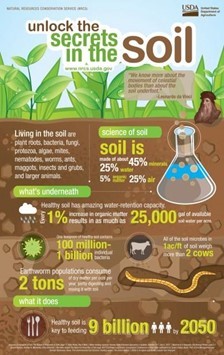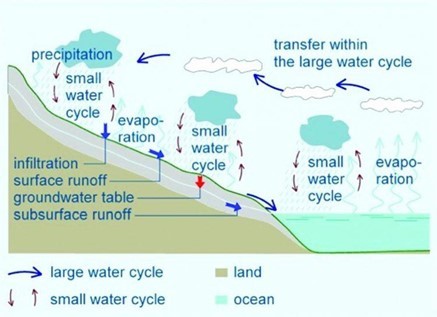Soil Carbon Capture Sequestration (SCCS)
Soil Carbon Capture Sequestration (SCCS) Delivering Low Carbon Intensity Scores and the Small Water Cycle: The Symbiotic Connection
By: Joel Stone, Lee Enterprises Consulting
Soil Carbon Capture Sequestration (SCCS), low carbon intensity (low CI) scores and the Small Water Cycle are connected through various ecological and hydrological processes that occur within terrestrial ecosystems. SCCS refers to the process of capturing and storing carbon dioxide (CO2) from the atmosphere in soil organic matter, primarily in organic carbon. This process is essential in the process to mitigate climate change by reducing atmospheric CO2 levels. Since during SCCS carbon is removed from the atmosphere and inventoried into
How the Processes are Interconnected
Root Exudates and Microbial Activity. Plants play a crucial role in both soil carbon sequestration and the small water cycle. When plants photosynthesize, they take in CO2 from the atmosphere and release oxygen (O2). A portion of the fixed carbon is then exuded through plant roots into the soil as organic compounds, such as sugars and organic acids. These exudates can serve as a food source for soil microbes. Microbes, in turn, break down these organic compounds, releasing CO2 back into the atmosphere through respiration. However, some carbon is also transformed into stable organic matter, which contributes to soil carbon sequestration.
Roots and Soil Structure
Plant roots help improve soil structure by binding soil particles together, creating channels for water movement, and enhancing soil stability. This improved soil structure increases water infiltration and fortifies storage capacity. Water infiltrating into the soil is essential for the small water cycle, as it recharges groundwater, sustains stream flow, and supports plant transpiration.
Transpiration
Transpiration is the process by which plants release water vapor into the atmosphere through small openings (stomata) on their leaves. This contributes to the small water cycle by increasing atmospheric moisture and facilitating cloud formation, which can lead to precipitation. Transpiration also helps cool the local environment.
Soil Moisture and Microbial Activity
The presence of organic carbon in the soil enhances water retention capacity. Soils with higher organic carbon content can hold more water. Adequate soil moisture is essential for microbial activity and the decomposition of organic matter, which affects the rate of carbon sequestration.
Feedback Loops
Changes in soil carbon content can influence the small water cycle, and vice versa. For example, increased soil organic matter can enhance water retention in the soil, reducing runoff and erosion. This, in turn, can lead to improved water quality and reduced sedimentation in water bodies.
Low CI Score
SCCS refers to capturing carbon dioxide (CO2) from the atmosphere and storing it in soil organic matter. This is primarily achieved through practices such as cover cropping, agroforestry, conservation tillage, and other sustainable land management techniques. This is important, since healthy soils act as a significant carbon sink, helping offset greenhouse gas emissions. When carbon is sequestered in the soil, it not only mitigates climate change, but also improves soil fertility, water retention, and ecosystem health.
Low Carbon Intensity Score Definition
The carbon intensity score is a measure of the amount of carbon emissions produced per unit of economic activity or other relevant metrics. In terms of products, services, or industries, a low carbon intensity score indicates that associated activities generate fewer greenhouse gas emissions per unit of output.
The importance of achieving a low carbon intensity score is a key goal for organizations and industries to reduce their environmental impact. It reflects a commitment to sustainable practices and the transition towards a low-carbon economy.
The Connection between SCCS and Low Carbon Intensity Score
Complementary Goals
Both SCCS and a low carbon intensity score contribute to the overall goal of reducing the carbon footprint and combating climate change. SCCS addresses emissions at the source by capturing and storing carbon in the soil, while a low carbon intensity score focuses on minimizing emissions per unit of output or activity.
Sustainable Agriculture Practices
Many agricultural practices associated with SCCS, such as reduced tillage and cover cropping, not only sequester carbon in the soil but also contribute to resource efficiency and lower carbon intensity in the agricultural sector. This can also favorably reduce herbicide and pesticide use, as well as reduce the need for synthetic fertilizers.
Organizations and industries that incorporate both SCCS practices and achieve a low carbon intensity score demonstrate a holistic commitment to sustainability. This approach acknowledges the importance of mitigating emissions, enhancing carbon sequestration, and promoting environmental responsibility. In the production of biofuels, a low CI score is important to qualify for Section 45Z – Clean Fuel Production Credit.
Section 45Z of the Inflation Reduction Act (IRA)
The IRA has extended several energy tax credits and also enacted some new energy credits, including Section 45Z, The Clean Fuel Production Credit. Most of this provision provides credit to producers of energy with a lower carbon footprint. This includes ethanol producers. The credit is scheduled to start in 2025 and extend to the end of 2027 (based on current law).
In summary, the connection between soil carbon capture and sequestration, and a low carbon intensity score, lies in their shared objectives of mitigating climate change and fostering sustainable practices, especially within the agricultural and industrial sectors. Implementing both strategies can contribute to a more comprehensive and effective approach to environmental stewardship.
SCCS and the Small Water Cycle are tightly linked in terrestrial ecosystems because the cycling of carbon through plants, soil, and microbes influences soil structure, water movement, and the availability of moisture for plant growth. Understanding these connections is crucial for sustainable land management practices and can help mitigate the impacts of climate change and support ecosystem health.
The Power & Influence of the Small Water Cycle

Sustaining Ecosystems
The small water cycle is essential for providing water to plants, animals, and microorganisms in terrestrial ecosystems. It ensures the availability of water for drinking, growth, and reproduction, which is critical for maintaining biodiversity.
Agriculture
Agriculture relies heavily on the small water cycle. Crops depend on local precipitation and soil moisture for growth, making the availability of water a primary factor in agricultural productivity.
Local Climate and Weather
The small water cycle influences local climate and weather patterns. Evaporation from local water bodies, such as lakes and rivers, and transpiration from vegetation, contribute to humidity levels and can influence cloud formation, rainfall, and temperature in a specific region.
Groundwater Recharge
Precipitation that infiltrates the soil contributes to groundwater recharge. Groundwater is a vital source of freshwater for drinking, agriculture, and industrial purposes in many areas around the world.
Water Quality
The small water cycle helps maintain water quality by flushing pollutants out of surface water bodies through runoff, and promoting filtration and purification of water as it moves through the soil.
Human Settlements
Human settlements, including cities and towns, rely on the small water cycle for their water supply. Local water sources, such as wells and rivers, are often integral to meeting the water needs of communities.
Natural Disasters
Understanding the small water cycle is crucial for predicting and managing local natural disasters, such as floods and droughts. Accurate predictions of local precipitation and soil moisture levels are essential for preparedness and mitigation efforts.
In summary, the small water cycle is vital for sustaining life, supporting ecosystems, influencing local climate and weather, and meeting human needs. It plays an integral role in the Earth’s hydrological system, working together with the larger global water cycle to ensure the availability and distribution of freshwater resources.
For further reading on the SCCS and Small Water Cycle: Briefing on SCCS, The Small Water Cycle & Global Warming, and Small Water Cycle Restoration: A new paradigm for water management
About the Author
Joel Stone is a leader in commercializing industrial biotechnology and synthetic biology. He is an accomplished executive, having held leadership roles at many start-up companies delivering new businesses and technologies over the past 40 years. He is also an original member of the Biofuels Digest Wolfpack due diligence team. Joel is a recognized thought leader in the convergence of synthetic biology with regenerative agriculture and an advocate for regenerative agriculture solutions for climate restoration. He is President and Executive Director of the non-profit Climate Systems Solutions. He serves as a Project Director at Lee Enterprises Consulting, overseeing matters involving Fermentation, Biobased Materials, Biofuels, Food Ingredients, Enzymes, Strategic Planning, Synthetic Biology, and Regenerative Agriculture.
About Lee Enterprises Consulting
Lee Enterprises Consulting has over 180 experts that can help navigate your bioeconomy needs. If you need assistance with your bioenergy project(s), please Contact Us.
Have some questions?
Not sure where to start?
Let's start a conversation. We're here to help you navigate
the bioeconomy with confidence.
